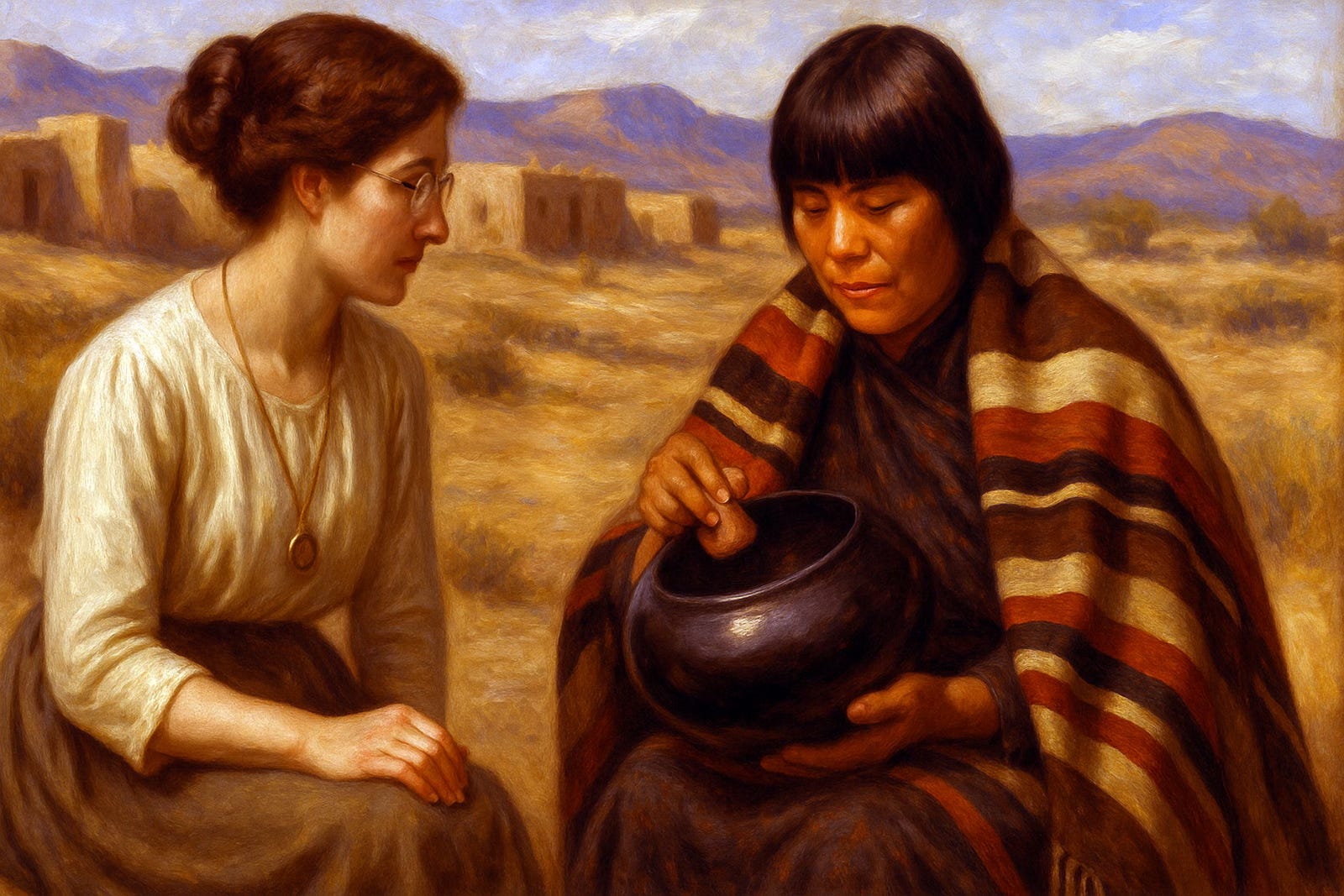Berta Carr, Witness to a Changing West
Bloodlines and Bandits, Part IV (Epilogue): Remembering Berta, An Enduring Voice from the Past.

A day or two before she died, Berta Carr, weak with advanced age, opened her eyes unexpectedly. At her side was her niece, once the tow-headed grandchild who was the last to grow up on the Carr prairie homestead, now a tearful woman bracing for the final farewell.
She held Berta’s hand lovingly, unwilling to let go.
“Don’t cry,” Berta whispered tenderly with waning energy.
“I’ve had such an unusual life. So many changes. I was privileged to see it all. Just think, I rode in a covered wagon into Indian Territory. Then I flew on a jet plane across country to see your new baby. Most people never have those kinds of experiences in life. Please, dear, there’s no need to cry. I’ve been such a lucky woman.”
Through many decades, the Carr family lived and worked their prairie homestead. But out of James and Julia’s seven children, Berta and her eldest sister Ola took very different paths.
Ola built a conventional life and married a prominent local man with wealth and social standing. She brushed against California movie glamour when one of her daughters became a leading high fashion model and married an actor celebrated as Hollywood royalty.
Although Berta often visited Ola’s family in Hollywood herself, she was never in the role of traditional wife or mother. Her path was restless, independent, and altogether unlike the life Ola embraced.
Instead, Berta dedicated herself to education with the determination to make a difference. She became obsessed with her studies at the age of fourteen, driven by the goal of passing the required examinations and securing a paid teaching position.
On the frontier in 1910, women had very few options for employment. Teaching was one of the few professions open to them, provided they could endure the arduous and exceptionally stringent government examinations.
However demanding the examinations may have been, the greater problem was the scarcity of teachers who were willing to move into the frontier settlements. Most adults of eligible age refused to uproot themselves for such a demanding job located in one of the most desolate regions of the United States, areas where loneliness and hardship were certain companions.
To fill the need, government officials bent the rules. A young girl who proved her intelligence and grit, and who could pass the exams with extraordinarily high marks, might just find herself in the rare situation of being placed at the head of a classroom while she was still in her teenage years.
In each designated district, there was only one paid teaching position, and the schoolmistress was responsible for children living on homesteads that stretched across many miles. She was contracted to teach every subject and all ages in a single-room schoolhouse. When daily lessons ended, she moved every few days from household to household, boarding with the families whose children she taught. Room, board, and meals were part of her pay, clearly specified in the community’s agreement if they wanted their children to have a school at all.
Berta received her teaching credentials just after her sixteenth birthday, and because the school year began only days later, she qualified by the narrowest margin.
Her first assignment placed her in a one-room schoolhouse on a remote stretch of the Oklahoma prairie, several days’ ride from her family home. The sturdy wooden building was a simple, boxy structure with a few desks, stools, and benches left inside for the students. A small cast-iron stove gave little heat, and a single chalkboard hung on the wall beside her desk.
Berta’s little schoolhouse stood alone against the horizon. It was surrounded by shaggy prairie grass and open to wind, storms, and sun. Children of all ages arrived each day on foot, on horseback, and by buggy. They carried slates and lunch pails, their faces wind-kissed and dusty.
Berta took the position seriously and worked tirelessly, teaching reading, writing, and ciphering. She added history and basic science to her curriculum so her pupils might have easier lives than what their settler families had endured.
Over time, Berta pursued advanced studies at the University of Oklahoma, earning a degree in Education and American History. With determined resolve, she committed herself to improving the lives of marginalized communities in the American West and followed through even when her efforts lacked family approval or social support.
From an early age, Berta believed education was the strongest tool that could allow those with fewer opportunities to build a better place for themselves and contribute meaningfully to the life around them.
Berta eventually chose not to marry and set aside the expectations reserved for women of her day. More than an avid reader, she occasionally wrote for magazines, newspapers, and scholarly journals about American and Native American history with particular attention to the developing Western states.
After finishing university, Berta returned to work on the frontier. During her time off, she traveled across the American West and into northern Mexico to explore the cultural arts of Indigenous peoples. She participated in hands-on art workshops, visited museums, and often sought out the experts who authored her favorite books. Berta, still within a reasonable distance of the university, even took at least one course every year that she could, firmly believing that continuous study was the best way to stay young.
The masterful artistry, craftsmanship, and creative traditions of the tribal arts she encountered held her attention. Usually Berta traveled alone and drove her own car for lengthy journeys when she visited Indigenous artists. Yet her friendships reached well beyond the realm of art; she formed close bonds with Native families from several tribes and cherished her visits with them.
“I wanted to see new things, all the things I had never seen before,” she would say when asked why she traveled on her own. “I wanted to experience life with a deeper meaning and live beyond the boundaries others tried to set down for me just because I am a woman.”
Shortly after University, she developed a reserved affection for a childhood friend, a man considerably older who had gained national recognition as a poet. Their connection grew from shared frontier roots and long conversations on art, literature, travel, and writing whenever they met. Her deepest feelings remained private, revealed only when she underlined a passage on unrequited love in her copy of his best-selling book.

Berta, My Mentor
Strong, intense, and ever studious, Berta stood taller than most. She spoke with precision, her diction touched by a Southern drawl.
Fashion mattered to her, and she was known for carefully choosing garments tailored to the highest standards. She insisted on the best regardless of the occasion, whether she was traveling, working, or in society.
Her blue-green eyes were piercing, her dark hair was typically braided and coiled at the crown of her head. She carried herself with quiet authority and was known for her quick wit and candor. Berta listened intently, replying with a truthfulness that left no room for doubt.
Berta was the first person I knew who treated healthy living as a discipline. She kept a balanced diet and spoke about the importance of organic produce long before it became common. She took vitamins and daily restorative walks in all kinds of weather.
In her bedroom, even at an advanced age, she used a slant board for sit-ups and would sometimes be found lying inverted for long periods, convinced this aided blood flow to the brain and kept her mind sharp. She followed this routine until the final months of her life. Regardless of whether this actually worked or not, she remained quick-witted and articulate to the end.
Early on, Berta joined the Unitarian Church in California, a choice that drew criticism from her devout relatives. She believed that people were fundamentally equal, regardless of skin color. To her, culture and education shaped opportunity far more than ancestry. She spoke of this sometimes with a bluntness that risked offense, though her intent leaned toward clarity rather than provocation.
Much of Berta’s life was spent in the company of Native Americans, some of whom later became widely recognized. In mid-life, after a brief retirement following over thirty years in the classroom, she chose to return to work and teach where she felt she was needed most. She accepted a position at a struggling school for young Black children in a small rural California town and remained there for several years. As the only white woman on staff, she often remarked on how much she loved “her children” there.
The Story Behind These Stories
In later years, Berta moved to Tucson, while I was still a child. Her failing eyesight left her increasingly dependent on her much younger brother. She took a small apartment near the University of Arizona.
By then, I had heard many of Berta’s tales so often that I felt a bit of envy for the life she had lived. My home was more than fifteen hundred miles away, so I often sent her my stories and poems, tucked inside my letters. She returned them, sometimes even the letters, marked with careful edits and honest critique, treating a child’s work with the rigor of a publisher. She offered no padding, only the intention to help me improve. She was teaching again, and it became our game.
During one extended visit, my parents were tied up with business in Tucson. My mother, with a full schedule of her own, devised a plan to keep me occupied while they were away. I still remember the morning she announced it. “If you really want to be a reporter,” she said briskly, “you can begin by interviewing Berta.”
Hours later, armed with a cheap tape recorder, a few cassettes, and a short list of hastily written questions, I was dropped at Berta’s modest apartment near the university.
I tapped on the door, nervous and unsure whether Berta would agree to the plan. There was no choice but to try. We had not spent much time together in person, and we were both formal at first. But when the recorder began to hum, Berta’s stories unfolded, one after another.
She was intent on passing down memories from significant periods in American history. Words, sights, sounds, and smells that might have vanished were recorded on tape instead.
We worked together for many hours over several days, until we were both exhausted. I was still quite young and often unsure of what to ask. There were questions and details that I longed to inquire about, but I held back, afraid I might seem rude, insulting, or simply too ignorant.
Each day, there was a time when I could tell that Berta had forgotten that the recorder was on. Then, her tone of voice would change.
It was an odd, haunting voice, a slow, raspy whisper that did not sound entirely natural. She told her stories as if she had stepped out of the present and into another time, describing the scenes as if she was actually there again.
As Berta concentrated on the details of what she vividly remembered, her eyes would grow distant but focused as if on something so far away. She described moments of joy, of pain, of adventure, gossip, and of moments I was not yet quite old enough to unravel.
Berta was summoning the details of a world she knew I would never see for myself.

You have just read my series here in Juicy History about Berta, called “Bloodlines and Bandits.” These stories are just a glimpse from those recordings and handwritten letters from both Berta and her sister, which I have since been privileged to own.
This is just a sampling of Berta’s words. She takes us back to wagon trains and wide open prairie lands, to the stubborn resolve of settlers who built new lives at the turn of the last century. In her words, she describes ruthless betrayals, the breaking of tribal nations, and the darker edges of the world she witnessed.
Berta valued truth. She insisted on it.
This series, “Bloodlines and Bandits”, is only a glimpse of what remains in her papers and archives. I am still working out how best to share the breadth of her stories.
So much more needs to be told.
In her own voice, Berta was nuanced and profound. The rest of the stories she experienced, and then shared, certainly remain timely, and at times, the topics are fiercely debated today.
Across her lifetime, Berta was known for her friendship with Native peoples and for taking bold, sometimes unpopular stands on their behalf. She sought justice and truth.
Postscript
If you have enjoyed Berta’s journey here on Juicy History, I would be grateful if you would simply touch that heart and add a Like to this work.
Small gestures like that help make this newsletter more discoverable to new readers.
So, please don’t be shy.
Comments are just as valuable when it comes to getting Juicy History out there.
Each Like or remark signals to Substack that these stories matter, and that helps bring my work to new readers who might not find this newsletter otherwise.
If you feel at all moved to share a thought, I would love to hear it.
And if you have not subscribed yet, please consider joining us! I am bringing forward as many true histories as I can about a wide variety of topics, all meant to surprise, engage, and keep you curious.
Yet again, to my founding and paid subscribers, and to all the many free readers who follow along, thank you. Your encouragement means more than I can say.
And, yes, there’s one last note!
Next week, I will share a Bonus Story to close this series. It is a recipe from Julia’s own kitchen dating back to about 1879-1883. This historical American dessert is perfect for summer, but can be carried into winter with just the slightest adjustment. Likely handed down from Julia’s mother, Martha, this is a unique, tasty treat that you can easily make in your own home!



What a life and what a treasure for you to have and to tell Berta’s stories.